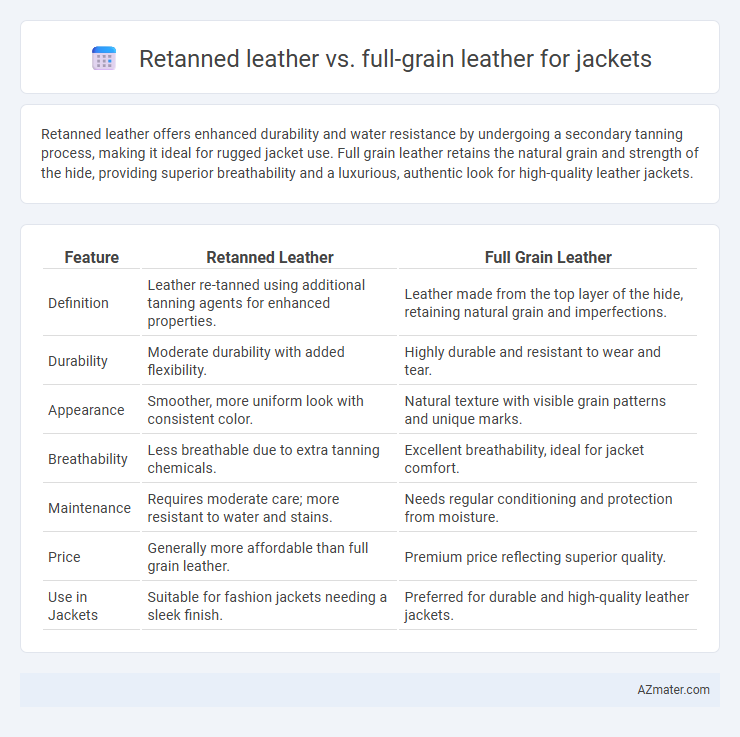Retanned leather offers enhanced durability and water resistance by undergoing a secondary tanning process, making it ideal for rugged jacket use. Full grain leather retains the natural grain and strength of the hide, providing superior breathability and a luxurious, authentic look for high-quality leather jackets.
Table of Comparison
| Feature | Retanned Leather | Full Grain Leather |
|---|---|---|
| Definition | Leather re-tanned using additional tanning agents for enhanced properties. | Leather made from the top layer of the hide, retaining natural grain and imperfections. |
| Durability | Moderate durability with added flexibility. | Highly durable and resistant to wear and tear. |
| Appearance | Smoother, more uniform look with consistent color. | Natural texture with visible grain patterns and unique marks. |
| Breathability | Less breathable due to extra tanning chemicals. | Excellent breathability, ideal for jacket comfort. |
| Maintenance | Requires moderate care; more resistant to water and stains. | Needs regular conditioning and protection from moisture. |
| Price | Generally more affordable than full grain leather. | Premium price reflecting superior quality. |
| Use in Jackets | Suitable for fashion jackets needing a sleek finish. | Preferred for durable and high-quality leather jackets. |
Introduction to Retanned and Full Grain Leather
Retanned leather undergoes a secondary tanning process that enhances durability, softness, and color consistency, making it ideal for jackets requiring a refined finish. Full grain leather retains the natural surface of the hide, including imperfections and grain texture, providing superior breathability and strength while developing a rich patina over time. Both types offer distinct advantages, with retanned leather emphasizing refined aesthetics and full grain leather highlighting natural authenticity and longevity.
What is Retanned Leather?
Retanned leather is leather that undergoes an additional tanning process after the initial tanning to enhance its durability, texture, and appearance, making it more resistant to wear and environmental factors. This process typically involves treatments with vegetable or synthetic tannins to improve the leather's softness and flexibility compared to untreated full grain leather. Retanned leather offers a balance between natural grain characteristics and enhanced performance, making it a popular choice for high-quality jackets that require both comfort and longevity.
What is Full Grain Leather?
Full grain leather is the highest quality leather, made from the top layer of the hide that includes all the natural grain and imperfections, offering superior durability and breathability. Retanned leather undergoes an additional tanning process to improve softness and flexibility, but full grain leather maintains its natural strength and develops a unique patina over time. For jackets, full grain leather provides exceptional resistance to wear while enhancing with age, making it the preferred choice for premium outerwear.
Key Differences Between Retanned and Full Grain Leather
Retanned leather undergoes an extra tanning process using various chemicals to enhance softness, durability, and water resistance, making it more flexible and less prone to stretch compared to full grain leather. Full grain leather retains the natural surface with visible grain, offering maximum strength, breathability, and a rugged aesthetic that develops a rich patina over time. While retanned leather is often preferred for jackets requiring pliability and easier maintenance, full grain leather is prized for its authenticity, longevity, and ability to age beautifully with use.
Durability: Retanned Leather vs Full Grain Leather
Retanned leather undergoes multiple tanning processes that enhance its resistance to moisture and wear, making it durable but slightly less robust than full grain leather. Full grain leather retains the entire grain layer, providing superior strength and natural breathability, which contributes to exceptional longevity for jackets. The dense fiber structure of full grain leather ensures better resistance to abrasion and tearing compared to retanned leather, ideal for heavy-use outerwear.
Appearance and Texture Comparison
Retanned leather typically exhibits a more uniform color and smoother surface due to additional tanning processes, enhancing softness while maintaining durability ideal for jackets. Full grain leather preserves the natural texture and imperfections of the hide, offering a rich, rugged appearance with pronounced grain patterns and increased breathability. The choice between retanned and full grain leather impacts jacket aesthetics, with retanned leather favoring consistent finish and full grain leather emphasizing authentic texture and character.
Comfort and Flexibility in Jackets
Retanned leather enhances jacket comfort by incorporating additional tanning processes that improve softness and suppleness compared to traditional full grain leather. Full grain leather retains its natural grain, offering superior durability and breathability but may feel stiffer initially, requiring break-in time to reach optimal flexibility. Jackets made from retanned leather provide immediate comfort and flexibility, making them ideal for wearers prioritizing ease of movement and a softer feel.
Maintenance Requirements
Retanned leather requires more frequent conditioning due to its additional chemical processing, which can strip natural oils and cause stiffness over time. Full grain leather maintains its durability and breathability with minimal upkeep, needing only occasional cleaning and moisturizing to preserve its natural texture. Proper maintenance of both types involves using pH-balanced leather care products to extend the jacket's lifespan and appearance.
Price and Value Considerations
Retanned leather generally costs less than full grain leather due to additional processing that enhances softness and flexibility but may reduce durability. Full grain leather, prized for its natural strength and aging properties, commands a higher price reflecting its superior longevity and premium quality. When choosing a jacket, evaluating the balance between upfront cost and long-term value is crucial, as full grain leather often offers better investment through durability and aesthetic appeal.
Which Leather Should You Choose for Your Jacket?
Full grain leather offers unmatched durability and natural texture, making it an ideal choice for jackets that age beautifully with use. Retanned leather undergoes additional tanning processes, enhancing softness and flexibility, which suits those seeking comfort and a more refined finish. When choosing your jacket, consider full grain leather for long-lasting resilience and retanned leather for a softer, more polished appearance.

Infographic: Retanned leather vs Full grain leather for Jacket
 azmater.com
azmater.com